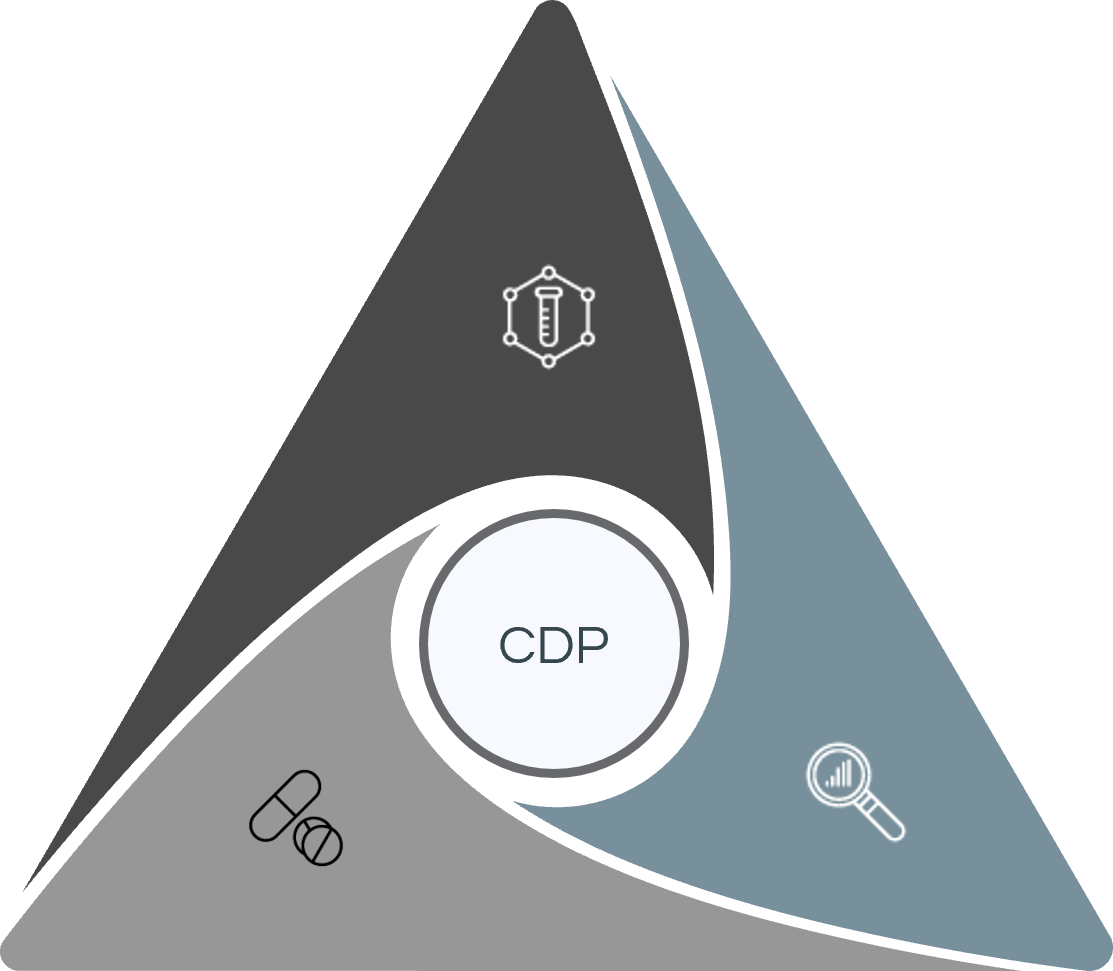Development Strategy: the added value of a comprehensive bespoke Indication Prioritization Exercise
Challenging Early-Stage Fundraising Environment Requires a Change in Thinking
Biotechs setting out on their fundraising journey will benefit from thinking deeply about the most appropriate indications for their assets. Indication Prioritization is a key first step in this process, requiring a holistic assessment of possible disease areas relevant to and asset’s mechanism of action in relation to the biology of the disease. This exercise is best done using a comparative scoring system personalized to the specific needs of each client, which allows a relatively objective decision to be made on the optimal disease and population in which to develop an asset. Indication Prioritization involves performing a deep dive into the literature, clinical trial results and underlying data in order to produce a landscape assessment for each indication. This blog discusses Adnovate’s approach to Indication Prioritization and its value in drug development.
The average overall costs of bringing a drug to market have increased substantially in the past decade to $4.5-5B1 taking around 9-10 years2. Particularly relevant for early-stage companies, the cost of Phase 1 studies has risen markedly and is now on average > $5M for an asset in development for an oncology indication. In parallel, the composite success rate (the overall probability of an asset that enters Phase 1 gaining marketing approval) has decreased to only 6.3%, and success through Phase 1 has fallen to an all-time low of 39%3. With these considerations and the current macroeconomic environment in mind, funding for early-stage companies has become far more challenging and the investment community is now looking to reduce their risk, becoming increasingly selective in its deployment of capital.
Biotechs setting out on their fundraising journey will benefit from thinking deeply about the most appropriate indications for their assets. Indication Prioritization is a key first step in this process, requiring a holistic assessment of possible disease areas relevant to and asset’s mechanism of action in relation to the biology of the disease. This exercise is best done using a comparative scoring system personalized to the specific needs of each client, which allows a relatively objective decision to be made on the optimal disease and population in which to develop an asset. Indication Prioritization involves performing a deep dive into the literature, clinical trial results and underlying data in order to produce a landscape assessment for each indication.
Using the outputs from a carefully conducted Indication Prioritization exercise, a Target Product Profile (TPP) can be generated The production of TPPs is covered in a separate blog here on the Adnovate Clinical website.
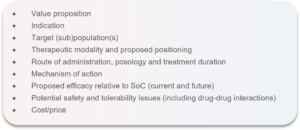
The TPP outlines the key characteristics of a product, including;
A number of TPP options are usually created, after which a process of alignment with the company’s strategy and risk appetite identify the key TPP to take forward. The TPP enables not only the creation of well-informed, risk-managed clinical plans but can also inform preclinical plans and translational strategy.
Development Plans, both clinical and non-clinical can be generated in parallel with the TPP, to meet its needs, in order to address risks and demonstrate product attributes and a competitive profile in a stepwise manner. The clinical development plan details information from Phase 1 to the client’s desired point of focus (e.g. end of Phase 1, proof of mechanism, proof of concept (PoC), approval, etc.), supported by detailed rationale. The production of Development Plans is also covered in a separate Adnovate Clinical blog. Among other aspects, they should cover;
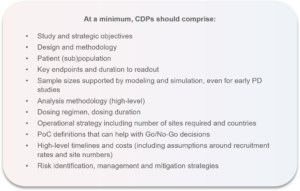
With outlines of the early clinical plans in hand, the exact non-clinical and CMC requirements can be ascertained and a route of entry into clinic from a regulatory and scientific perspective plotted, which in turn will enable data collection to support aspects of the TPP.
TPPs and Development Plans incorporating this level of thinking will foster scientific and commercial credibility, thus increasing the likelihood of successful funding and generating the potential to maximize value creation.
Indication Prioritization
Indication Prioritization is the process by which different potential indications for a platform or drug are identified, evaluated and compared/contrasted. This exercise enables a company to strategically select indication(s) with the greatest potential for successful development and value creation to meet corporate objectives. The scope of Indication Prioritization may range from a relatively narrow exercise with few starting options to a far broader consideration with numerous alternatives. However, regardless of scope it is personalized to the strategy of each individual Biotech, since each company has different priorities. A one size fits all approach to this exercise using standard templates may not provide the best outputs for every company.

Frequently, organizations will have preferred areas of clinical focus for the development of their assets that align with organizational goals, overall strategy and pipeline activity. This often dictates the non-clinical and target validation work that has already been carried out. Where this is the case, a client may provide a relatively limited list of potential indications from which they wish to select a priority area of focus. Here, it is crucial that gaps and biases in thinking are addressed during the indication prioritization exercise.
In other cases, indication selection may be purely target-driven, concentrating on which indication, regardless of therapeutic area, provides the optimal fit from multiple perspectives, primarily driven by the science.
In larger organizations the Indication Prioritization follows a deep landscape assessment carried out by a large dedicated cross-functional team, each with deep expertise in the relevant area. Indication Prioritization allows the development of a TPP, which is part of the integrated development plan, which undergoes thorough vetting by management before approval and is a living document.
In the startup biotech environment, due to the capital and human resource constraints, it has often been considered adequate to conduct this exercise in a relatively superficial manner, often without incorporating assessments of the added long-term value that comes from considering market positioning, patient access and the reimbursement landscape to underscore the estimation of early product valuations.
Given the invaluable foundation that comprehensive bespoke landscape assessments and Indication Prioritizations give to TPPs, they act to arm the internal fundraising team with key knowledge from multiple functional aspects, adding credibility to pitches. Landscape assessments also provide the basics for creating future regulatory documentation around benefit-risk profiles and for justifying study and program designs.
Partnering with a consultancy that can provide relevant deep expertise to supplement the knowledge of a client’s internal team and conduct a detailed landscape assessment and Indication Prioritization will result in the development of a future-proofed and evidence-based TPP. Combining this with a logical Development Plan demonstrating how claims in the TPP will be achieved with clear Go/No-Go stage gates will maximize the chances of successful funding.
Indication prioritization exercises objectively assess the goodness of fit of an indication for a given asset across a number of parameters, generating a comprehensive landscape assessment for each indication in the process. Areas appraised and scored include:
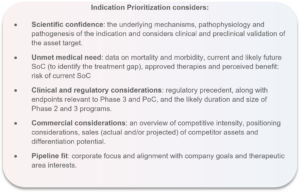
During the course of multiple previous indication prioritization exercises for various clients, Adnovate Clinical has developed a comprehensive rating system that delivers sub-scores for each of the parameters above, which are then combined to create an objective overall score that can be used to facilitate indication prioritization.
Individual scores can be compared per parameter, and overall (or mean) scores compared per indication. According to the client’s wishes, weightings can be applied to individual elements within the scoring system.
After indication prioritization has been carried out, a variety of TPP options can be created for consideration. With the basics of the TPP in hand, the development of early clinical development plans and, later, non-clinical development plans can begin.
Conclusions
Comprehensive, objective, science-led Indication Prioritization based on in-depth landscape assessment underpins and lays the foundation for robust TPPs and Development Plans. Analysis of the basic science enables evidence-based recommendations to be made on suitable indications. Research into the pathophysiology, epidemiology and SoC within those disease states allows appropriate target populations and sub-populations to be identified. This information in combination with analysis of the competitive landscape enables likely future SoC (including the predicted future residual treatment gap) and safety/efficacy hurdles to be identified and the size of the addressable target population to be estimated. Regulatory input and expertise is used to assess the viability of the TPP and identify any routes for niche regulatory positioning (Orphan Drug Designation, accelerated review etc.).
With the indication prioritization exercise and its accompanying landscape assessment in hand, TPPs and Development Plans can be generated. A well-thought-out TPP and a Development Plan that supports this key document are essential for regulatory and commercial success in drug development. However, these documents can also clarify risk, cost and timelines and give a clear roadmap for investment milestones with the probability of success giving confidence to potential investors. A comprehensive development package combined with a competitive but realistic TPP allows Biotech companies to clearly communicate to investors the future value of an asset and how the winning profile will be achieved, increasing confidence and the likelihood of a successful funding raise.
Adnovate Clinical brings together the requisite team with cross-functional expertise to produce a high-quality, well-considered rationale for the most appropriate indication for a Biotech’s assets: landscape assessments, TPPs, and Development Plans maximize the chances of clearing regulatory hurdles and provide clear visualization to address future unmet needs and commercial success.
By taking a ‘skin in the game’ approach to fundraising interactions, the Adnovate Clinical team remains on hand to defend the recommended approaches during pitches and due diligence activities, giving management teams access to the expertise they need to convey credibility to future investors.
For more information, please get in touch at: https://www.adnovateclinical.com/contact-us/
References
- Roche R&D presentation September 2023. Roche analysis of EvaluatePharma (data as of March 2023). Note, new molecular entities, including biologics.
- Roche R&D presentation September 2023. Note includes Phase 1b expansions for oncology, single arm Phase 2 and randomized Phase 2 studies.
- Global trends in R&D report, February 2023.
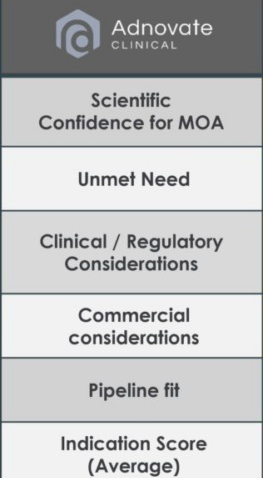;)


